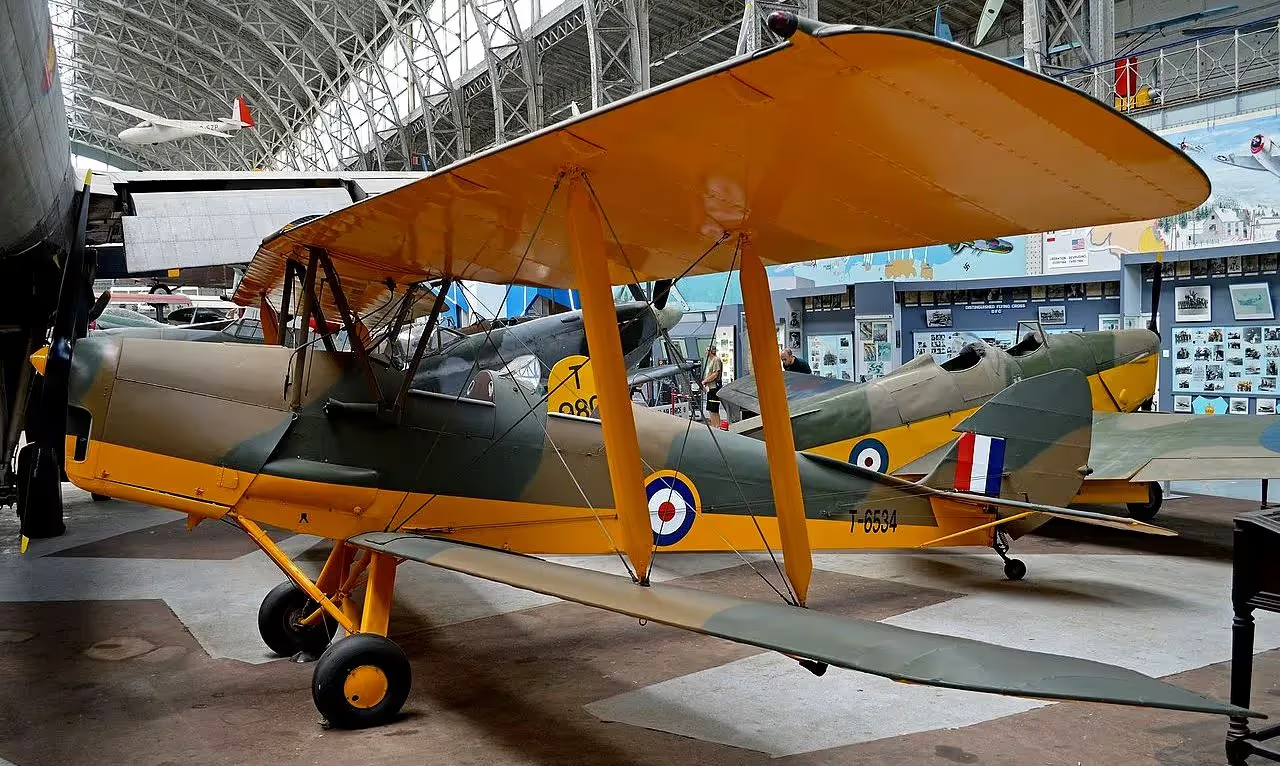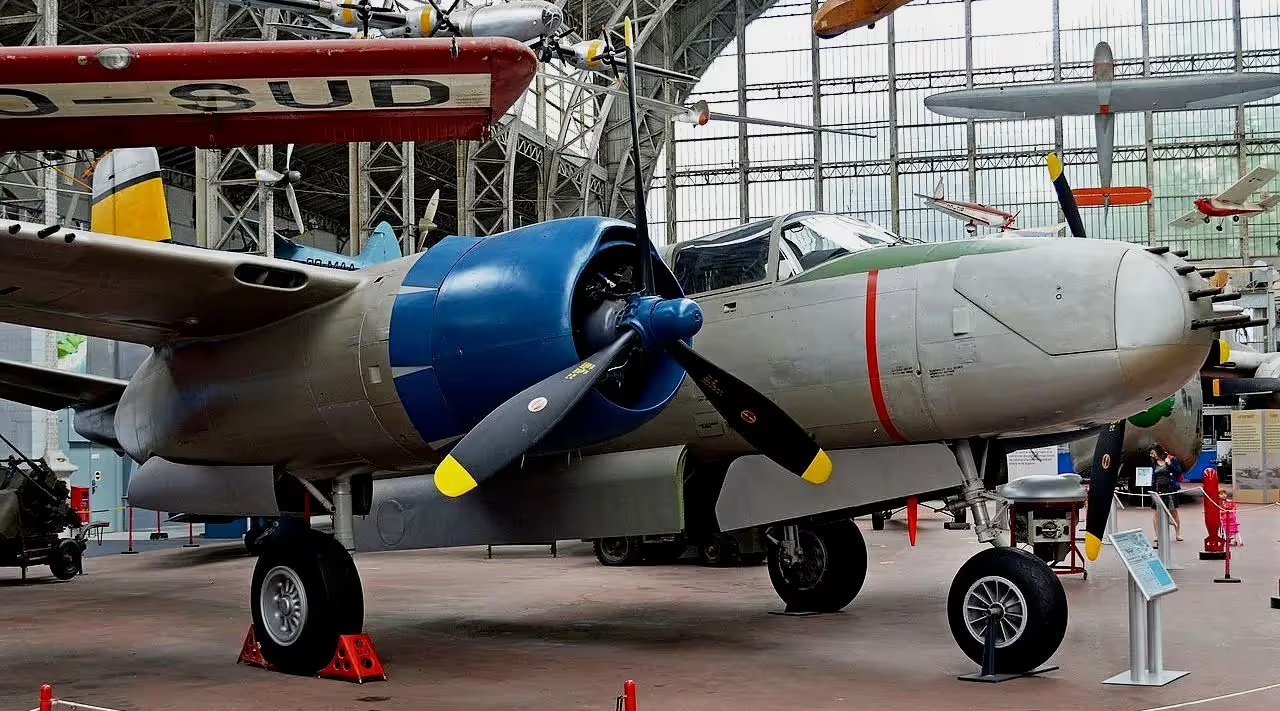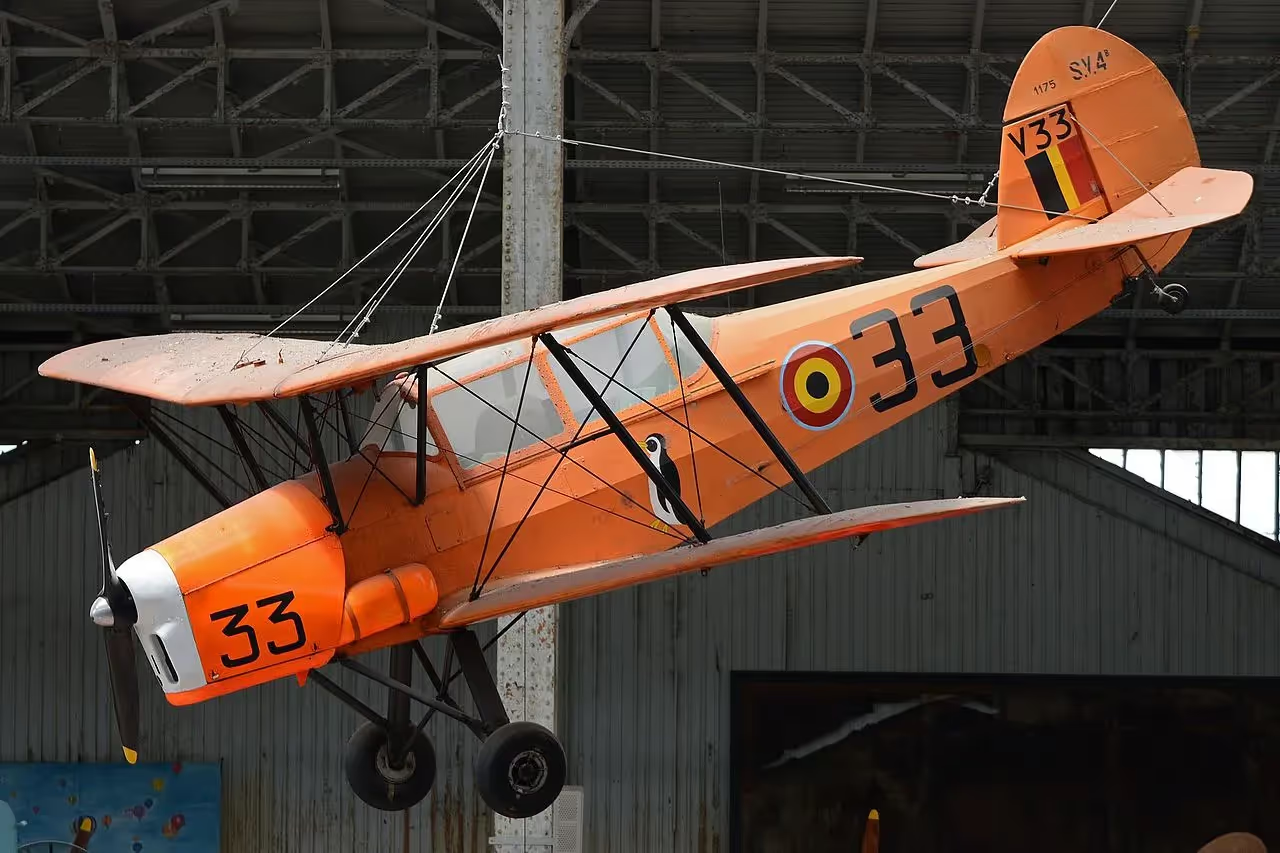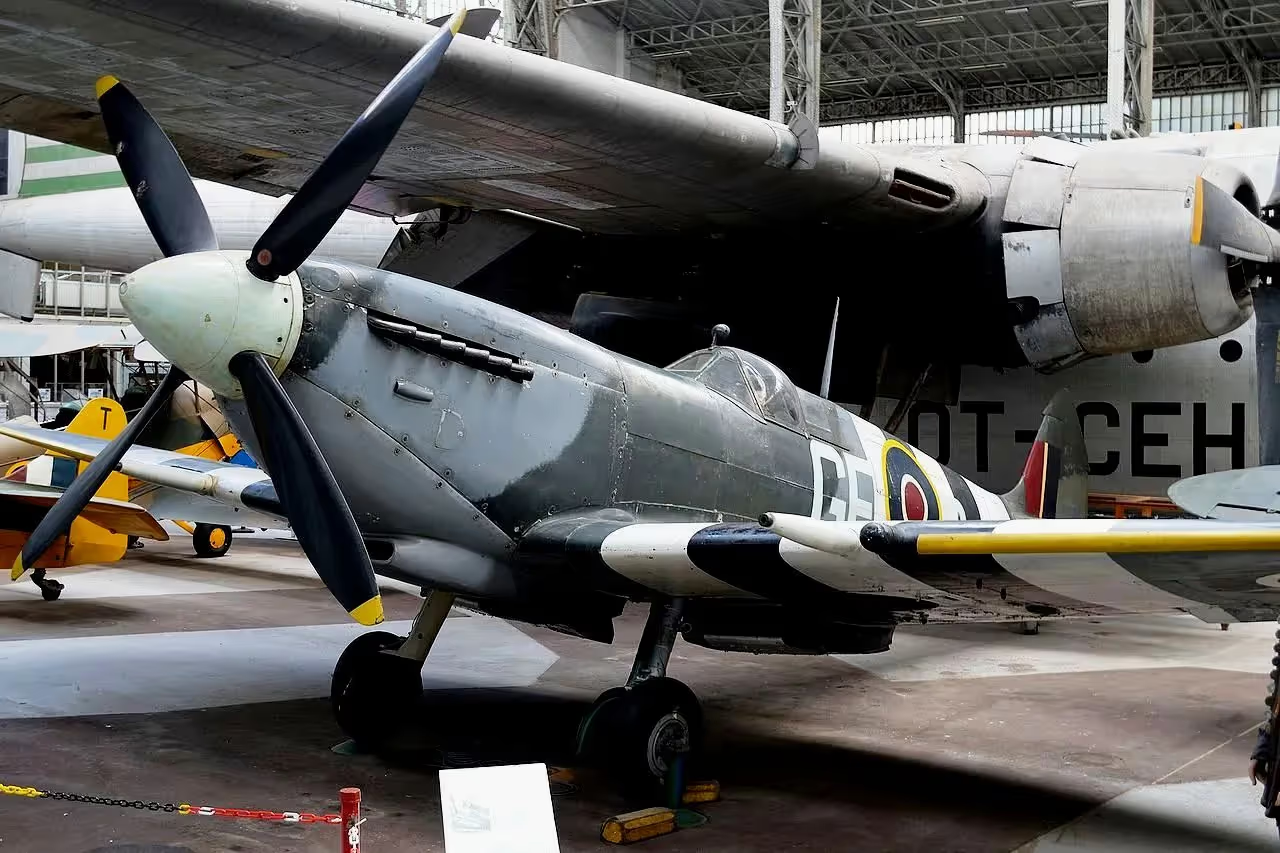Belgium: Warplanes of the Second World War preserved
Warplanes of the Second World War preserved in Belgium
The aim of this website is to locate, identify and document Warplanes from the Second World War preserved in Belgium. Many contributors have assisted in the hunt for these aircraft to provide and update the data on this website. Photos are as credited. Any errors found here are by the author, and any additions, corrections or amendments to this list of Warplane Survivors of the Second World War in Belgium would be most welcome and may be e-mailed to the author at [email protected].
Avions de guerre de la Seconde Guerre mondiale conservés en Belgique
Musee Royal de l'Armee et d'Histoire Militaire (Royal Museum of the Armed Forces)


(Alan Wilson Photos)
Airspeed Oxford Mk. I (Serial No. 016), c/n PAC/W/936. This Oxford served during the Second World with the RAF (Serial No. MP455). It was one of 30 ordered by Belgium in 1947 for communication and multi-engined training duties, with 12 more being ordered later. It served with the Belgian Air Force (Serial No. O16), between July 1947 and January 1960. It is now on display Royal Museum of the Armed Forces and Military History (aka Brussels Air Museum) in Brussels, Belgium.

(Alan Wilson Photo)
Auster AOP.6 (Serial No. VT990), Belgian Air Force (Serial No. A11), c/n 2826, Reg No. OO-FDE. This Auster was built in the UK, but but delivered directly to Belgium in October 1947. It served with the Belgian Army until December 1957 when it was sold off and became Reg. No. OO-FDE in civil use. It has been restored to military condition and is on display at the Musee Royal de l'Armee et d'Histoire Militaire, Brussels, Belgium.



(Alan Wilson Photos)
Bristol (Fairchild) Bolingbroke Mk. IVT (Serial No. 9895), c/n 11-880-207, and parts of (Serial No. 10038). This Bolingbroke is a composite restoration mostly using parts from (Serial No. 9895) and (Serial No. 10038), which was briefly airworthy in the UK in 1987 as Reg. No. G-MKIV. 9895 has been part of the museum since it was rescued from Canada in 1971, but restoration was only completed in 1996 once the additional components of 10038 became available. The aircraft is painted to represent Blenheim (Serial No. L9416), XD-A of RAF No. 139 Squadron, which crash landed near Hoepertingen, Belgium while on a mission to Maastricht on 12 May 1940. The squadron lost seven aircraft on this mission. She is now displayed at the Musee Royal de l'Armee et d'Histoire Militaire, Brussels, Belgium.



(Alan Wilson Photos)
Commonwealth CA-13 Boomerang (Serial No. A46-139), “Phooey”, Reg. No. NX32CS. Based on a North American T-6 airframe, rebuilt using original Boomerang parts. Antwerp, Belgium.

(Alan Wilson Photo)
de Havilland DH.82A Tiger Moth (Serial No. T6534), c/n 84875, Belgian Air Force (Serial No. OO-EVT). On dispaly at the Musee Royal de l'Armee et d'Histoire Militaire, Brussels, Belgium.

(Alan Wilson Photo)
de Havilland DH.89A Dragon Rapide (Serial No. R5922), Reg. No. G-AKNV, c/n 6458. Built in 1939 for the RAF, this aircraft remained in service until 1947 when she was sold off to the Lancashire Aircraft Corporation. It was moved to Ireland in 1953 as Reg. No. EI-AGK, but returned to the UK in 1955, back as G-AKNV and then with Fairey Aviation. She stayed with Fairey overall, but by 1958 was actually based in Belgium as Reg. No. OO-AFG, with Avions Fairey SA, remaining with them until 1962. She was then reregistered as OO-CNP and began a brief life with parachutists at the ‘Centre National de Parachutisme asbl’ at Wevelgem. By late 1966, however, she was withdrawn from use and stored until saved in 1973 when a very long restoration began. She has recently been completed and is nicely finished in her original Lancashire Aircraft Corporation colour scheme. She is on display at the Musee Royal de l'Armee et d'Histoire Militaire, Brussels, Belgium.



(Alan Wison Photos)
de Havilland DH.98 Mosquito NF Mk. 30 (Serial No. MB24), c/n 984597, ND-N. This is one of only two remaining night-fighter Mosquitos, the other being de Havilland DH.98 Mosquito NF Mk. II (Serial No. HJ711), at Elvington in Yorkshire, UK. This late model example was built for the RAF (Serial No. RK952), but was transferred to the Belgian Air Force in 1953 as (Serial No. MB24). It was retired in 1957, and is now on display at the Royal Museum of the Armed Forces and Military History (aka Brussels Air Museum) in Brussels, Belgium.

(Alan Wilson Photo)
Douglas C-47B Skytrain (Dakota), K16, Reg. No. OT-CWG.



(Alan Wilson Photos)
Douglas A-26B Invader (Serial No. 44-34765), c/n 28044, AN-J, “Mission Completed”. One display in the Royal Museum of the Armed Forces and Military History. Brussels, Belgium


(Alan Wilson Photos)
Fairey Battle Mk. I (Serial No. R3950), c/n 1899. 70. Although in accurate Belgian Air Force markings, this rare Fairey Battle has no actual Belgian history. It was built as a standard Mk. I for the RAF. In 1941 it was transferred to the RCAF (Serial No. 1899), and was converted to a TT.I target tug. It was retired in 1945, sold off and it remained unrestored until changing owner in 1970. In 1972 it moved to the Strathallan Aircraft Collection in Scotland where the restoration to airworthy condition continued. In 1987 it was sold to Charles Church but ti was moved to the IWM at Duxford for temporary static display. In 1990 it was delivered to Brussels in a Belgian Air Force C-130 and has since been on display at the Royal Museum of the Armed Forces and Military History, still under restoration.
(Alan Wilson Photo)
Fieseler Fi 156 Storch (Wk. Nr. 5503), coded KR+QX, Reg. No. OE-ADT, built in 1941. This aircraft landed in Sweden and was interned on 4 April 1945. It became a Swedish Air Force S-14b (Serial No. Fv3822). It was later registered as OE-ADT for civil use in Austria, possibly for spraying work. It is now preserved and on display at the Musee Royal de l'Armee et d'Histoire Militaire, Brussels, Belgium.
Flug + Werk Fw 190 A-8/N
In 1997, Flug + Werk GmbH, a German company, began building new Fw 190 A-8s, with a run of 20 aircraft being produced. These aircraft are new reproduction builds from the ground up, using many original dies, plans, and other information from the war. The construction was sub-contracted to Aerostar SA of Bac?u, Romania; both companies have been involved in a number of warbird replica projects.
Werk numbers (Wk. Nr.) continued from where German war production numbers ended, with the new Fw 190 A-8s being identified as "Fw 190 A-8/N" (N for Nachbau, meaning "replica"). A fewof these Fw 190s were fitted with original tail wheel assemblies salvaged from a small cache remaining from the Second World War. Initial flights of the Fw 190A-8/N were carried out in November 2005.
As original BMW 801 engines were no longer available, a Chinese licensed Soviet-designed engine, the Shvetsov ASh-82FN 14-cylinder twin-row radial engine of similar configuration and slightly smaller displacement (41.2 litres versus 41.8 in the original BMW powerplants) was installed. The Soviet engines powered a number of the Fw 190s former opponents including the Lavochkin La-5 and La-7. A few customers specified American Pratt & Whitney R-2800 motors be installed in their model, even though those engines are larger than the ASh-82 with different mounting points requiring some modification. As part of the run of 20 examples, FlugWerk also produced a limited number of "long nose" Fw 190D examples powered by Allison V-1710s.
Flug + Werk Fw 190D-9 (Wk. Nr. 990006), painted as (Wk. Nr. 210102), Eric Vormezeele, Brasschaat, Anterp, Belgium.




(Alan Wilson Photos)
Hawker Hurricane Mk. IIc (Serial No. LF658), painted as (Serial No. LF345), c/n unknown. After wartime RAF service, this Hurricane was transferred to Belgium as an instructional airframe until 1951 when she joined the Royal Museum of the Armed Forces and Military History in Brussels.
Hawker Hurricane Mk. IV (Serial No. KZ321), Reg. No. OO-HUR, currently the only airworthy Mk. IV. It was imported from Canada in early 2018. It has been returned to airworthy status, for a private owner, by Flying Aces Services & Training. It made its first flight in Belgium on 4 November 2018 at the Brasschaat Airfield.
Hawker Fury FB.10, coded 00-ISS, painted in Iraqi Air Force colours, Reg. No. VH-ISS, restored to airworthy status with the original Bristol Centaurus engine.
Hispano HA-1112-M1L Buchon c/n 201 (Serial No. C.4K-131), OO-MAF. This aircraft took part in the move "Battle of Britain", ex-Victory Air Museum", White 1", "Sabine", Eric Vormezeele Collection, Brasschaat.


(Alan Wilson Photos)
Junkers Ju 52-3mg7e (Wk. Nr. 5670). This aircraft was built for the Portuguese Air Force in 1937 and originally flew as (Serial No. 109), later changed to (Serial No. 6309.) It was retired in 1972 and stored in Lisbon for the Portuguese Air Force Museum until it was shipped to Belgium in 1985 for restoration to fly, by the SABENA Old Timers. This project was abandoned and the aircraft went on permanent display at the Royal Museum of the Armed Forces and Military History, Brussels, Belgium.

(Alan Wilson Photos)
Miles M.14A Magister (Serial No. T9800), c/n 2037. After RAF service this Magister was passed to the Belgian Air Force as an instructional airframe. By 1947 it had been made airworthy and ended up flying as (Serial No. G-1). It was sold in 1953, and became Reg. No. OO-NIC) in private hands. It was rescued in the 1970s, and was restored using parts of (Serial No. T9705). It and is now on display at the Royal Museum of the Armed Forces and Military History, Brussels, Belgium.


(Alan Wilson Photo)
Morane-Saulnier MS.230 (Serial No. F-BGJS), c/n 1075. This aircraft is a composite rebuild including parts of (Serial No. F-BEJO), c/n 1066, which is still airworthy at La Ferte Alais, France. Twenty four of the type saw Belgian military service between 1931 and May 1940. None of these survived, so this machine represents them, at the Royal Museum of the Armed Forces and Military History, Brussels, Belgium.


(Alan Wilson Photos)
North American AT-6D Texan (Serial No. 42-84169), Belgian Air Force (Serial No. H21), c/n 88-15950. Built as an AT-6D for the US military but immediately transferred to the RAF as Harvard Mk. III (Serial No. EZ256), this aircraft went directly to South Africa for the SAAF as (Serial No. 7630). It returned to the RAF in 1946 and then joined the Belgian Air Force in 1947. It flew with them until 1959 when it went on display at the Royal Museum of the Armed Forces and Military History, Brussels, Belgium.
North American P-51D-25NA Mustang (Serial No. 44-72922), "Scat VII", Reg. No. PH-VDF, Jan van der Flier, Antwerp, Belgium. Airworthy.


(Alan Wilson Photos)
Percival Proctor Mk. IV (Serial No. P4), c/n H.578. This Proctor was built during the Second World War for the RAF (Serial No. NP171). It is one of six that were transferred to the Belgian Air Force in 1947 for training wireless operators, later seeing more use as communications aircraft. This example served from June 1947 to August 1951 and is now on display at the Musee Royal de l'Armee et d'Histoire Militaire, Brussels, Belgium.

(Alan Wilson Photo)
Piper L-18C Super Cub (Serial No. 53-4749), , c/n 18-3149, Belgian Army (Serial No. OL-L87). On display at the Musee Royal de l'Armee et d'Histoire Militaire, Brussels, Belgium.

(Alan Wilson Photo)
Schleicher Grunau Baby III (Serial No. PL37), c/n 82/55, Belgian Air Force, in service from March 1955 to roughly 1974. Postwar redesign, with an enclosed cockpit, by Edmund Schneider. On display at the Musee Royal de l'Armee et d'Histoire Militaire, Brussels, Belgium.

(Alan Wilson Photo)
Stampe et Renard SV.4B, Belgian Air Force, Belgian Air Force Serial No. 18), c/n 1160, (Serial No. OO-GWD). In military service from October 1949 to January 1971. It was converted to a single-seater, and is on display at the Stampe & Vertongen Museum, Antwerp Airport, Belgium.

(Alan Wilson Photo)
Stampe et Renard SV.4B, Belgian Air Force (Serial No. V33), c/n 1175. In service from April 1952 to May 1976. Previously on display in the terminal building at Brussels Airport. Now on display at the Musee Royal de l'Armee et d'Histoire Militaire, Brussels, Belgium.

(Alan Wilson Photo)
SNCAN SV.4B Stampe, Belgian Air Force (Serial No. V42), c/n 1184, (Seria No. OO-WIL), privately owned, Florennes, Belgium.

(Alan Wilson Photos)
Stampe et Vertongen SV.4 Belgian two-seat biplane fuselage, c/n 1198. Belgian Air Force (Serial No. V56).

(Alan Wilson Photo)
Stampe et Renard SV.4D Stampe (Serial No. OO-SRS), c/n 1208. This was the last SV.4 built and was fitted with a 175hp Mathis engine making it the sole SV.4D.

(Alan Wilson Photo)
SNCAN SV.4B Stampe, Belgian Air Force (Serial No. V57), c/n 1199. RAF No. 510 Squadron operated one of these aircraft "liberated" by Belgian pilots Léon Divoy and Michel Donnet in 1941, and flown from occupied Belgium to England. On display at the Royal Museum of the Armed Forces and Military History, Brussels, Belgium.


(Alan Wilson Photos)
Stampe et Vertongen SR.7B Monitor IV, c/n 1003. Belgian two-seat trainer, Reg. No. OO-SRZ. The SR.7B was originally designed by Farman and designated the F.500.


(Alan Wilson Photos)
Supermarine Spitfire LF Mk., IXe (Serial No. MJ783), c/n CBAF.IX1301. This Spitfire joined the Belgian Air Force in 1948 and was given (Serial No. SM15). It was retired in 1951 and became part of the national collection. It is on display at the Royal Museum of the Armed Forces and Military History, Brussels, Belgium.

(Alan Wilson Photo)
Supermarine Spitfire 361 LF Mk. XVIE (Serial No. TD248).
RAF Form 78 for (Serial No. TD248), included the following data: No. 4262, Castle Bromwich Aircraft Factory (CBAF), powered by a Merlin 266 engine, 6 MU, 11 May 1945, Aeroplane and Armament Experiment Establishment (AAEE), Boscombe Down (BDn), No. 6955 Squadron, Army Cooperation, 5 Jul 1945, coded 8Q-T, serviced on site by 54 MU from party from Cambridge, 31 Dec 1947, returned to No. 695 Squadron, new code 4M-E, 13 May 1948?, 2 Civil Anti-Aircraft Cooperation (CAAC) unit, Little Snoring, 31 Aug 1951, 9 MU, Cosford. In storage 27 May 1954, non-effective stock (NES), 14 Dec 1954, No. 610 Squadron, County of Chester, RAAF Hooton Park, as display aircraft coded DW-A, 4 Jan 1955, Royal Auxiliary Air Force, disbanded aircraft awaiting disposal No. 1366 Armament Training Camp (ATC) Chester at Sealand as 7246M, 8 Apr 1959, to 30 MU Sealand for display, 31 Jan 1967. Extant RAF Sealand, coded DW-A, 7246M, Reg. No. G-OXVI, to the Stampe Museum, Antwerp, Belgium.
Antwerp-Deurne Airport
Curtiss P-40E Warhawk (Serial No. OO-WHK). USAAF (Serial No. 41-13570), Soviet Air Force "51 White", shot down in 1942, ditched in a lake near Murmansk, recovered decades later and restored. Airworthy.





